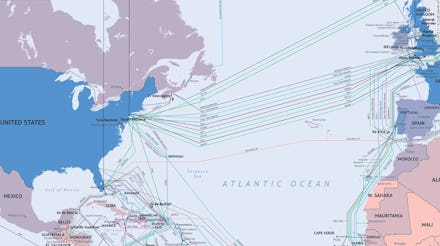These Maps Show the Thousands of Intricate Undersea Cables Connecting Us to the Internet

Growing up in the digital age has allowed us to think about the Internet as a kind of natural resource – something we have because of course we do.
But it's easy to forget that a technology so ubiquitous and central to our daily lives requires solid materials to function. Enter the maps below: The telecommunications research firm Telegeography has created these images depicting the incredible network of fiber optic cables that transport 99% of the world's international Internet traffic.
Check them out:
Image Credit: CNN
Wow. Over 300 of these cables line the ocean floor. They've been installed by a relatively small group of global telecommunications companies (all labeled on the map), which are also responsible for their maintenance and repairs.
A cable's installation process begins when the companies send survey vessels to study their proposed routes. These studies reveal a number of critical elements that need to be taken into account: archaeological features of the ocean floor, marine habitats, permit requirements and active fishery zones. Underwater builders then lay the cables directly onto the seabed, except for the high damage-risk sections within 1,500 meters of the shoreline that are buried underground using sea plows.
These cables are also installed with a good degree of slack, thereby minimizing possible damage from underwater geological activity. They are surprisingly thin, with a diameter of just about 2.7 inches, but sturdy enough to last a quarter century. "External aggression" accounts for about 90% of the damage they recieve whether it's ship anchors dropping on them or earthquakes whipping them about. Some reach depths of over 8,000 meters, which is only slightly less deep than Mount Everest is tall.
What about price? Telegeography research director Alan Mauldin tells CNN that the price of a cable usually depends on how many times it reaches land: "A complicated cable that lands in 10 different countries with thousands of kilometers per link will cost much more than one linking just two points." A recent cable traversing the Pacific Ocean cost $300 million, for example. Another one that reaches numerous locations in Asia cost $400 million.
Obviously this means the more money you have, the more cables you can afford. America Movil for example — a company backed by famous Mexican billionaire Carlos Slim — is constructing a huge new cable linking the U.S. to Mexico and many other Latin American countries. It should be completed sometime this year.
The future. The goal at this point is to improve service, especially to underserved parts of the world. "Basically we have now wired the ends of the Earth, almost," says Mauldin. "What's left is generally very remote island communities. Absolutely there can be improvements, having one cable is often not enough, we need to have multiple cables to provide a balanced and reliable way to access the world; it's not good enough anymore to have a cable out of service for weeks if it gets damaged. If you're a user in that country it's not acceptable, you expect seamless high quality net access all the time."
There's still plenty of room to add more cables and implement these improvements. Studies suggest their environmental impact is minimal, so for the time being, telecom companies can install deep seas cable without worrying about oil pipeline-level damage to the ocean floor. Barring unforeseen setbacks, global Internet connection will only improve in the coming years.